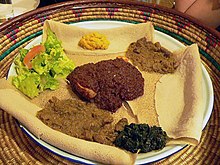Injera

Injera (Ge'ez እንጀራ, IPA /ɨnʤǝra/, sometimes transliterated enjera) or taita is a pancake-like bread made out of teff flour. It is traditionally eaten in Ethiopia, Eritrea, Northern Kenya and Somalia (where it is also called canjeero) . The flour is mixed with water and allowed to ferment for a few days, as with sourdough starter. Because of this process, injera has a slight sour taste. The injera is then ready to fry into large flat pancakes, done either on a specialised electric stove or fire. Injera compares to the French crepe and Mexican tortilla as a flatbread cooked in a circle and used as a base for other foods.
A variety of stews, and sometimes salads, are placed upon the injera for serving. Using one's right hand, small pieces of injera are torn and used to grasp the stews and salads for eating. The injera under these stews soaks up the juices and flavours of the foods and, after the stews and salads are gone, this bread is also consumed. Injera is thus simultaneously food, utensil, and plate. When the entire "tablecloth" of injera is gone, the meal is over.
The most valued grain used to make injera is from the tiny, iron-rich grain teff. Teff has almost no gluten at all, so any bread made from teff would not rise like regular breads. Teff is also a good substitute for people allergic to wheat gluten. However, its production is limited to certain middle elevations and adequate rainfall regimes, so it is relatively expensive for the average household. Since the overwhelming majority of highland Ethiopians are poor farming households, they must grow their own subsistence grain, so wheat, barley, corn, and/or rice flour may be used to replace some or all of the teff content. Most would agree that this is done at the expense of flavor. There are also different varieties of injera, such as nech (white) and tikur (black).
Injera is eaten daily in every household, so cooking it requires a lot of time and resources. In Ethiopia, the bread is cooked on a large, black, clay plate over a fire. This set-up is a stove called a mitad, which is difficult to use, produces large amounts of smoke, and is dangerous to children. Because of this cooking method, much of the area’s limited fuel resources are wasted. But in 2003 a research group was given the Ashden award [see external links] for designing a new type of stove for cooking injera. The new stove uses available fuel sources (including dung) for cooking injera and other foods efficiently. Several parts are made in the central cities of the countries, while other parts are molded from clay by women of local areas.
Outside of the Ethiopian Plateau, injera may be found in groceries and restaurants specializing in Ethiopian, Somali or Eritrean foods.
